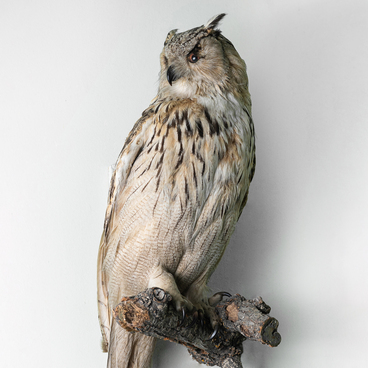The skull of the woolly mammoth Mammuthus primigenius was found on the territory of the Volsky district. Scientists claim mammoths lived there about 100,000 years ago.
The exhibit — a braincase — is completely free of tissues and washed. The structure of a yellow-brown bone is porous. It is possible to see frontal bones on the front part, even though the top of the skull is badly broken off and partially chipped. Under the frontal bones, there is a preserved opening for the proboscis with two nasal septa. The eye socket is on the right side. The occipital lobe of the skull is also broken off. Two large, elongated teeth are visible in the lower part. The surface of the teeth is ribbed.
The skull with an upper jaw, like other skeletal fragments found next to it, belonged to a baby mammoth. Adult individuals grew up to 3.4 meters with a weight of about 6-8 tons. A woolly mammoth was significantly larger than the modern African savanna elephant, which lives in Africa.
The woolly mammoth, as a species, evolved from its ancestors — the steppe mammoth — that lived on the territory of Eurasia during the Middle Pleistocene epoch. It appeared in Siberia about 450,000 years ago. It came to North America from Siberia through the lands of the modern Bering Strait, and 300,000 years later came back to Asia and spread to Europe.
The woolly mammoth used to live in the tundra steppe — the areas with both steppe and tundra vegetation. The mammoth ate grass, branches of willow, larch, and pine. It needed 180 kilograms of food a day.
The mammoth skull, like of other elephants, differed from the skulls of other land animals. Long maxillary and inter-maxillary bones, forming thin-walled tubes, held heavy tusks. The opening of the nasal cavity was high on the forehead between its eyes, almost like that of whales. A small internal capsule was deep under a thick, up to 30-35 centimeters, layer of frontal sinuses — airspaces separated by thin bone walls. The upper permanent teeth were in thin-walled alveoli — tooth sockets, but the lower jaw was more massive.
The woolly mammoth died out around 10 thousand years ago when the tundra steppe turned into swamps and taiga forests due to the Allerod oscillation. The last individuals that lived in isolation on Wrangel Island died only 4 thousand years ago due to the lack of food and inbreeding — closely related mating.
Mammoths were useful for ancient people. They were hunted by the Heidelberg people, whose descendants were Neanderthals, and then Cro-Magnons — the ancestors of Homo sapiens. A human being used mammoth skins, bones, and tusks to make weapons, tools, and jewelry.
The exhibit — a braincase — is completely free of tissues and washed. The structure of a yellow-brown bone is porous. It is possible to see frontal bones on the front part, even though the top of the skull is badly broken off and partially chipped. Under the frontal bones, there is a preserved opening for the proboscis with two nasal septa. The eye socket is on the right side. The occipital lobe of the skull is also broken off. Two large, elongated teeth are visible in the lower part. The surface of the teeth is ribbed.
The skull with an upper jaw, like other skeletal fragments found next to it, belonged to a baby mammoth. Adult individuals grew up to 3.4 meters with a weight of about 6-8 tons. A woolly mammoth was significantly larger than the modern African savanna elephant, which lives in Africa.
The woolly mammoth, as a species, evolved from its ancestors — the steppe mammoth — that lived on the territory of Eurasia during the Middle Pleistocene epoch. It appeared in Siberia about 450,000 years ago. It came to North America from Siberia through the lands of the modern Bering Strait, and 300,000 years later came back to Asia and spread to Europe.
The woolly mammoth used to live in the tundra steppe — the areas with both steppe and tundra vegetation. The mammoth ate grass, branches of willow, larch, and pine. It needed 180 kilograms of food a day.
The mammoth skull, like of other elephants, differed from the skulls of other land animals. Long maxillary and inter-maxillary bones, forming thin-walled tubes, held heavy tusks. The opening of the nasal cavity was high on the forehead between its eyes, almost like that of whales. A small internal capsule was deep under a thick, up to 30-35 centimeters, layer of frontal sinuses — airspaces separated by thin bone walls. The upper permanent teeth were in thin-walled alveoli — tooth sockets, but the lower jaw was more massive.
The woolly mammoth died out around 10 thousand years ago when the tundra steppe turned into swamps and taiga forests due to the Allerod oscillation. The last individuals that lived in isolation on Wrangel Island died only 4 thousand years ago due to the lack of food and inbreeding — closely related mating.
Mammoths were useful for ancient people. They were hunted by the Heidelberg people, whose descendants were Neanderthals, and then Cro-Magnons — the ancestors of Homo sapiens. A human being used mammoth skins, bones, and tusks to make weapons, tools, and jewelry.



